COVID-19 modelling: B.C.'s daily cases could approach record levels by late September
The number of COVID-19 cases recorded daily in British Columbia could approach record levels by late September under a "moderate transmission" scenario, according to new modelling data presented Tuesday.
One projection shared by provincial health officer Dr. Bonnie Henry indicated the number of reported COVID-19 cases could reach approximately 1,200 per day by Sept 27, depending on transmission and vaccination rates.
B.C.'s record for the most cases announced in a single day was 1,293 on April 18.
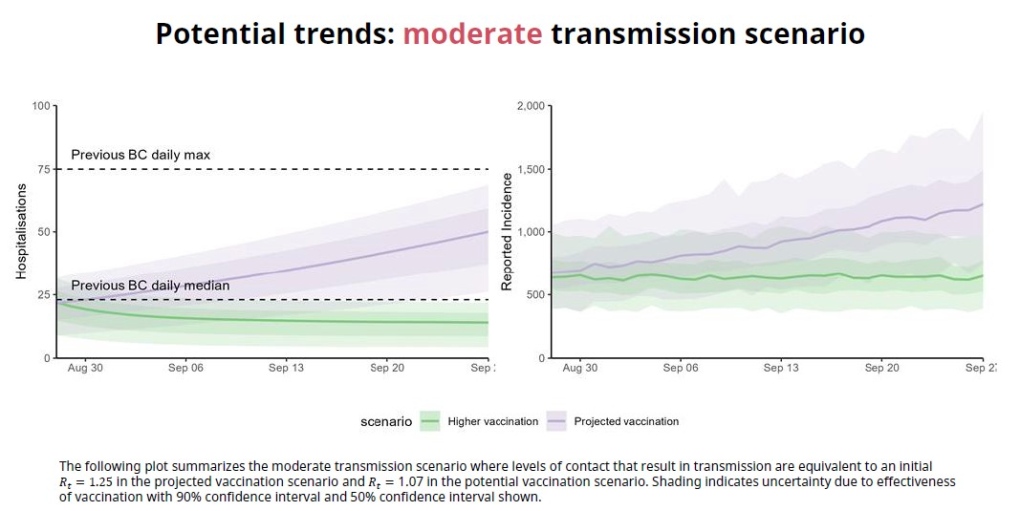
Under the most optimistic scenario presented, daily case numbers would gradually decrease below 500 per day in the middle of the month. Over the last week, the province has recorded an average of 683 cases daily.
The incremental progress health officials are hoping for depends largely on increasing vaccination numbers, particularly in the Interior Health and Northern Health regions, where pockets of under-immunized populations have seen rapid surges in COVID-19 cases this summer.
Henry stressed that vaccination remains overwhelmingly effective at preventing transmission and hospitalization, describing the province's current situation as a "pandemic of the unvaccinated."
"Primarily what we're seeing is people who are fully vaccinated have a very low and stable case rate across the age groups. This tells us that vaccines work, regardless of the variant that's been spreading," she said, referring to the highly contagious Delta strain that now dominates in Canada.
According to B.C.'s data, when adjusted for age differences, the unvaccinated are 12 times likelier to get COVID-19 than those who have received both doses of vaccine, and 35 times likelier to require hospitalization if infected.
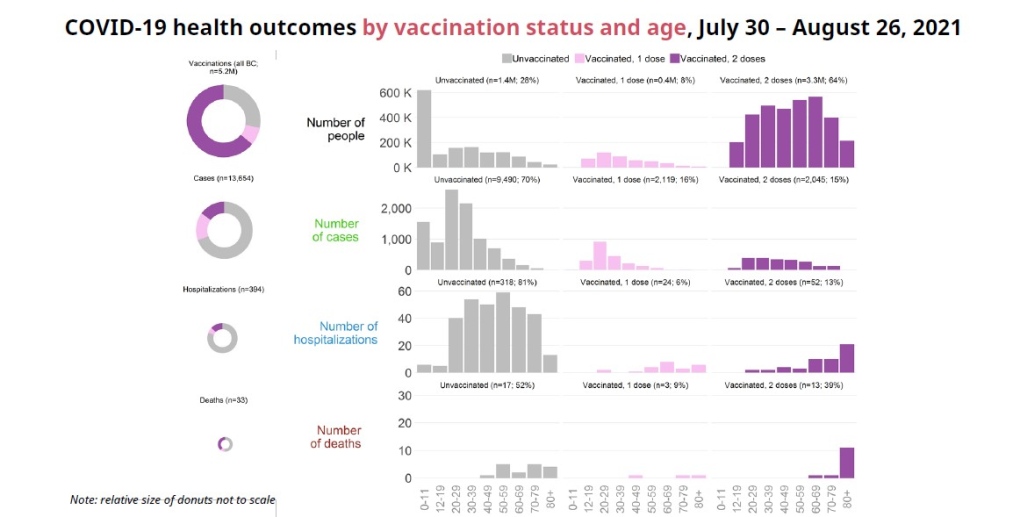
There are breakthrough cases, however, and those are particularly troubling when they affect elderly people whose bodies are less capable of mounting a strong defence against COVID-19 after vaccination, Henry said.
That increased vulnerability explains why 39 per cent of deaths recorded between July 30 and Aug. 26 involved people who were fully immunized, according to officials.
"Deaths continue to occur primarily among older people – they are most at risk," Henry said.
"We had 33 deaths in that month, and a third of them were in people who were in long-term care."
By comparison, the fully vaccinated made up just 15 per cent of cases and 13 per cent of hospitalizations over the same period.
But some regions are trailing far behind the rest of B.C. when it comes to immunizations, including several local health areas within Northern Health where fewer than 50 per cent of the eligible population had received a first dose by Aug. 23.
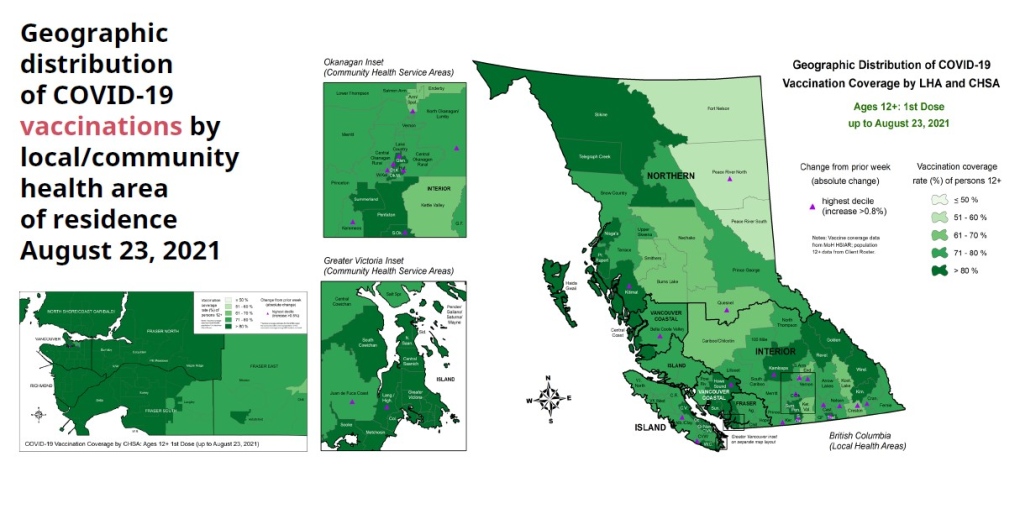
Vaccination rates remain lower than average in several areas of Interior Health as well. Henry noted the health authority region has accounted for about 50 per cent of the cases recorded since July 1, despite representing only 15 per cent of B.C.'s population.
Health officials said there is reason to be optimistic. The virus's reproductive rate – which measures how many additional infections are caused by each new case – has come back down to 1.1, after nearing 1.5 at the end of July.
"It still means that for every person infected, they're passing it on to one other person and that means our trajectory is going to be continuing," Henry said. "What we want to do is be able to reduce those infectious contacts – so the chances we're going to transmit to somebody else – and bring it down below one."
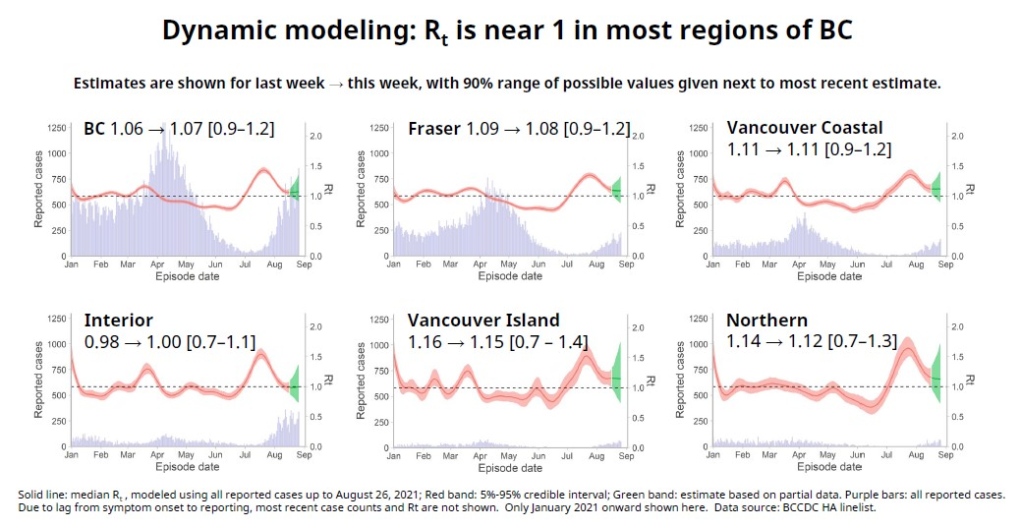
The government began implementing local COVID-19 restrictions in the Interior Health region early this month, and has since brought back a province-wide mask mandate. Officials have also reported an encouraging increase in vaccination registrations since the announcement of a vaccine passport system, which is scheduled to start being phased in on Sept. 13.
Without any vaccinations at all, B.C.'s case numbers would be skyrocketing to upwards of 2,000 per day in early September, according to the modelling. Hospitalizations would also be increasing by more than 100 patients per day.
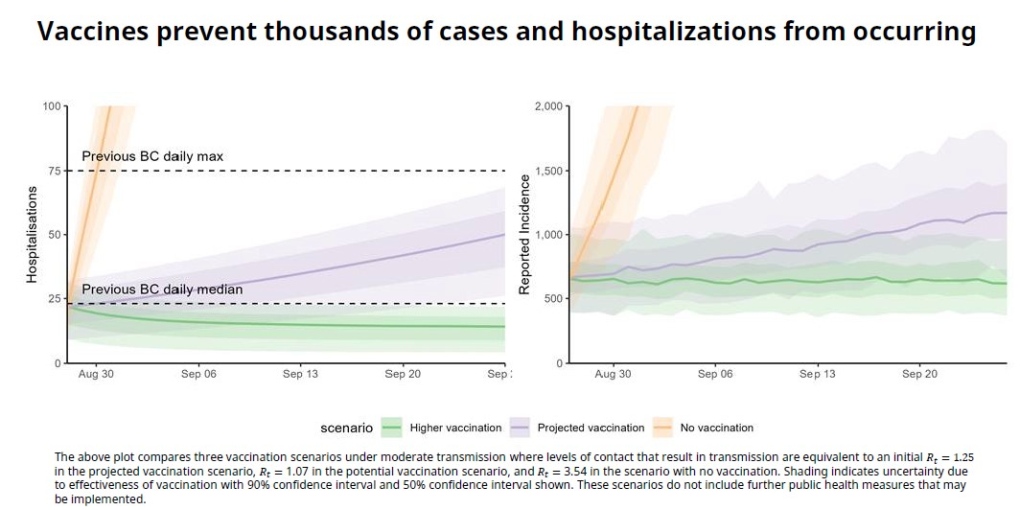
Going forward, Henry said the government will only be presenting modelling projections that extend one month into the future.
The provincial health officer pointed to previous modelling from June that underestimated the chances of case numbers surging into another significant wave.
"Models help us understand what are the important things that we need to pay attention to, and they can tell you what may happen but none of them can tell you what will happen," she said.
"And much of it depends on the measures we put in place, how effective those measures are, and our own behaviour.".
CTVNews.ca Top Stories

Parts of Canada hit with freezing rain, heavy snowfall warnings, expected to last through Monday
Significant snowfall and heavy rain hit parts of Canada on Sunday and the weather system is expected to continue into Monday morning and throughout the day.
Who is Abu Mohammed al-Golani, the leader of the insurgency that toppled Syria's Assad?
Abu Mohammed al-Golani, the militant leader of the insurgency in Syria, has spent years working to remake his public image, renouncing to ties to al-Qaida.
Suspect wanted after victim forcibly confined, assaulted, and threatened with death in Scarborough
Police have released images of an individual who allegedly forcibly confined, and assaulted and threatened to kill another person in southwest Scarborough over the weekend.
Jay-Z accused of sexually assaulting 13-year-old in 2000 incident along with Sean 'Diddy' Combs
A woman who alleges she was sexually assaulted by Sean 'Diddy' Combs has amended her lawsuit to include allegations that she was also assaulted by Jay-Z at the same party.
Trump calls for immediate ceasefire in Ukraine and says a U.S. withdrawal from NATO is possible
Donald Trump on Sunday pushed Russian leader Vladimir Putin to act to reach an immediate ceasefire with Ukraine, describing it as part of his active efforts as U.S. president-elect to end the war despite being weeks from taking office.
A timeline of the murder of UnitedHealthcare CEO Brian Thompson and the search for his killer
The search for the killer of UnitedHealthcare CEO Brian Thompson's has stretched beyond New York City and continues. Here's what we know so far.
Baby found dead in south Edmonton parking lot: police
Police are investigating the death of an infant in south Edmonton.
Pantone names its colour of the year for 2025
Pantone has named an 'evocative soft brown' its colour of the year for 2025, continuing a tradition that has now run for more than a quarter of a century.
Do you recognize these men? RCMP seek Metro Vancouver grandparent scam suspects
Mounties in Metro Vancouver have released photos of two men alleged to have been involved in “numerous” so-called grandparent scams earlier this year, hoping the public can help identify them.
































